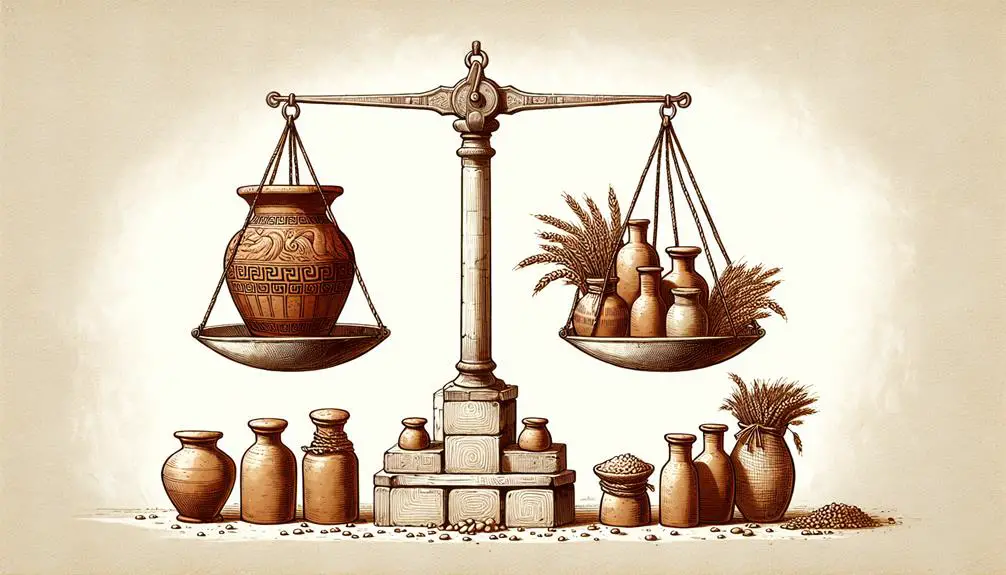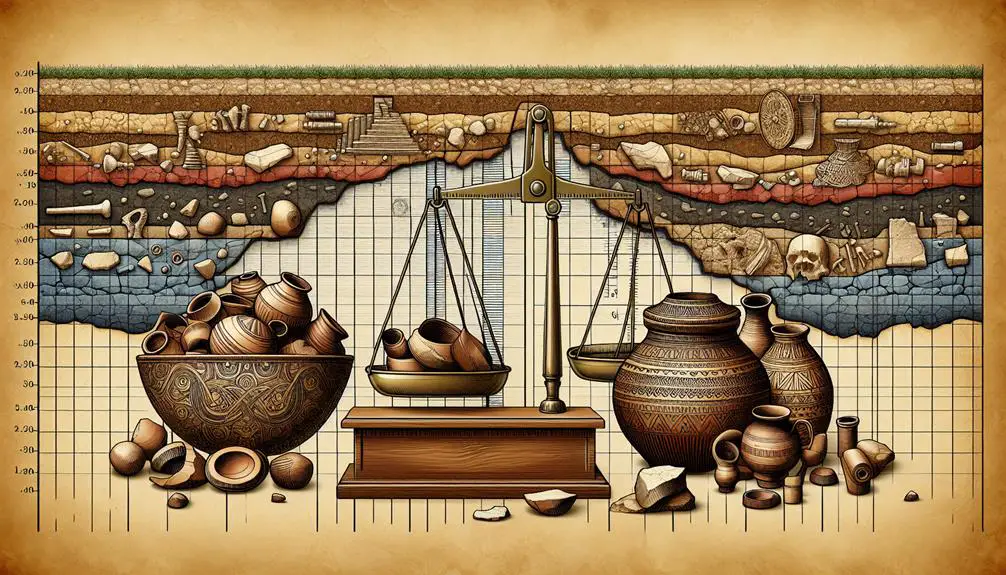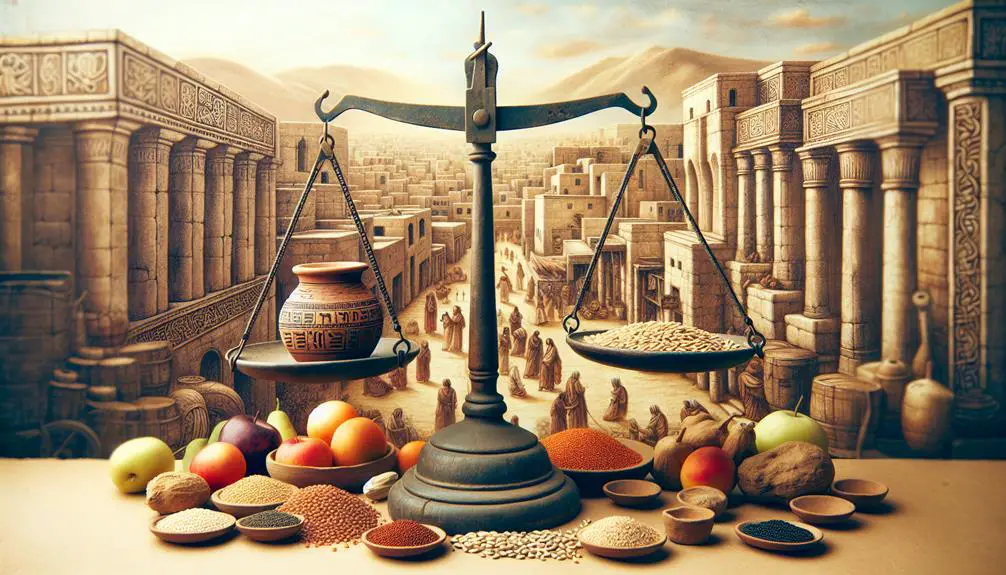Navigate the ancient biblical unit of the homer to uncover its significance and value in historical contexts, revealing a forgotten measure of abundance.

How Much Is a Homer in the Bible
In the tapestry of biblical narratives, the homer stands as a symbol of sustenance and abundance, woven intricately into the fabric of ancient societies. You might find yourself pondering its real-world equivalence today, given its frequent mentions in scriptures.
This ancient unit of measurement, pivotal in understanding the economics and daily life of biblical times, offers a fascinating glimpse into the past. Yet, grasping its exact value in contemporary terms requires a journey through history and scripture.
Uncover the layers of significance the homer holds in biblical stories and how it shaped the civilizations of yesteryear, inviting a deeper exploration into its enduring legacy.
Key Takeaways
- A biblical homer is approximately equivalent to 220 liters or 6 bushels.
- The homer was used for both dry and liquid measures in biblical times.
- Its size and capacity could vary based on the substance being measured.
- Understanding the homer enhances comprehension of ancient economic and cultural practices.
Defining the Biblical Homer

In biblical terms, a homer represents a unit of measurement used for both dry and liquid substances, illustrating its significance within ancient economic and agricultural contexts. You'll find that the homer origins are deeply embedded in the societal fabric of the times, serving as a cornerstone for transactions and trade. Scholars often debate the exact quantity a homer signifies, leading to measurement controversies that persist to this day.
The analysis of ancient texts reveals that a homer's size and capacity could vary, depending on the substance it measured. This variability contributes to the ongoing scholarly debates, making it challenging to pinpoint a precise conversion to modern units. You must understand that the lack of standardized measurement tools at the time further complicates this issue, as does the evolving nature of language and terminology used in biblical scriptures.
Efforts to resolve these measurement controversies involve cross-referencing biblical accounts with archaeological findings. Yet, despite these challenges, the homer remains a key unit for understanding the economic and social structures of ancient societies. As you delve deeper into the study of biblical measures, keeping these controversies in mind will enhance your comprehension of the text's historical and cultural backdrop.
Historical Context and Usage

Understanding the historical context and usage of a homer sheds light on its pivotal role in the economy and daily life of ancient societies. This measurement, frequently mentioned in ancient texts, was not merely a unit but a reflection of cultural practices deeply embedded in the fabric of these communities. The homer was central to agrarian economies, influencing trade, taxation, and even religious offerings.
Aspect |
Significance |
|---|---|
Trade |
Essential for establishing fair exchange rates in markets. |
Taxation |
Basis for calculating dues owed to governing authorities. |
Religious Offerings |
Integral in determining the size of contributions to temples. |
Conversion Into Modern Units
To grasp the relevance of a homer within today's metrics, it's crucial to delve into its conversion into modern units. Understanding the metric equivalency of a homer not only illuminates its size but also enhances our comprehension of ancient texts and the magnitude of transactions or provisions mentioned. Scholars have worked meticulously to achieve volume accuracy in these conversions, acknowledging that the precise metric equivalency is critical for accurate historical and cultural analysis.
A homer, as a unit of volume used in ancient times, primarily for dry substances like grains, translates to approximately 220 liters or 6. bushels in today's measurements. This conversion is derived from careful analysis of historical records, archaeological findings, and cross-referencing with other ancient measures. The emphasis on volume accuracy ensures that modern readers can better understand the scale of agricultural, economic, and daily life activities described in biblical texts.
Achieving such metric equivalency involves a complex process. Researchers must consider variations in the homer's usage across different locations and periods, as well as the potential changes in volume standards over time. This scholarly endeavor ensures that when you encounter a reference to a homer in biblical passages, you're equipped with a precise understanding of its modern-day equivalent, enhancing both the interpretation and appreciation of ancient texts.
Comparisons With Other Biblical Measures

Having established the modern equivalency of a homer, let's now compare it with other biblical measures to further illuminate its role in ancient contexts. This comparison not only clarifies the scale and usage of the homer but also enriches our understanding of cultural interpretations and measurement origins in biblical times.
- Ephah: Roughly one-tenth of a homer, the ephah was often used for grains and dry commodities. This shows the homer's significance in large-scale agricultural assessments and storage.
- Bath: Equal to an ephah in volume but used for liquids, the bath demonstrates the versatility of ancient measurement systems, adapting to different materials yet maintaining a coherent standard.
- Omer: A smaller measure, one-tenth of an ephah or one-hundredth of a homer, the omer highlights daily consumption rates against the backdrop of larger allocations and offerings.
- Talent: Primarily a measure of weight, not volume, the talent allows for fascinating insights into the economic and trade practices of the time, contrasting the homer's utility in quantifying agricultural produce.
Through these comparisons, we gain a nuanced perspective on the homer's place within a broader system of biblical measures, shedding light on the intricate web of cultural interpretations and measurement origins that shaped ancient life.
Archaeological Evidence and Insights

Archaeological excavations have unearthed artifacts and structures that provide concrete evidence of the biblical measurement system, including the homer, offering insights into ancient economic and social practices. You'll find that the integrity of these findings, often questioned, plays a pivotal role in understanding the ancient world's complexities. Artifact validity and excavation challenges are inherent in the process, reflecting the meticulous work required to piece together historical puzzles.
Artifact |
Significance |
Challenge |
|---|---|---|
Storage Jars |
Indicate volume measures |
Establishing precise capacity |
Inscriptions |
Provide direct references to measures |
Interpreting ancient scripts |
Settlement Layouts |
Reflect economic organization |
Distinguishing chronological layers |
Trade Records |
Offer insights into economic scale |
Authenticity and context interpretation |
These artifacts and records, despite the challenges, have significantly contributed to our understanding of how the homer was used and its role in society. The excavation challenges, from ensuring artifact validity to interpreting ancient texts, underscore the complexities of archaeological scholarship. Yet, it's through overcoming these hurdles that you gain invaluable insights into the economic and social fabric of ancient cultures, bringing the biblical measure of the homer to life.
The Homer in Ancient Economies

The homer, a unit of measure deeply embedded in ancient economies, reveals the intricate balance between agricultural productivity and economic transactions in historical societies. This ancient measure wasn't just a way to quantify grain; it played a pivotal role in the broader economic system, influencing trade and currency exchange across regions.
Consider the following aspects that highlight the homer's impact:
- Trade Routes: The homer standardized transactions along trade routes, facilitating the exchange of goods by providing a common measurement. This standardization was crucial for expanding trade networks, as it allowed for the efficient exchange of commodities between distant regions.
- Currency Exchange: In economies where barter was prevalent, the homer served as a basis for currency exchange. It enabled traders and merchants to assign value to various goods and services, making complex economic transactions possible.
- Agricultural Planning: The use of the homer in agricultural contexts allowed societies to plan planting and harvesting according to expected yields, ensuring food security and stability.
- Taxation: Rulers and governments used the homer to levy taxes on agricultural produce, which was essential for funding public works and administration.
The homer thus stood at the confluence of agriculture, trade, and finance, illustrating the sophistication of ancient economic systems.
Significance in Biblical Narratives

You'll find that the homer's symbolic meaning in biblical narratives offers a window into the spiritual and moral lessons valued by ancient societies.
By examining measurement comparisons, you gain insight into the economic and social structures that underpinned these communities.
The historical context in which the homer is mentioned illuminates the everyday lives and challenges faced by people in biblical times.
Symbolic Meaning
In biblical narratives, a homer's significance extends beyond its physical measure, symbolizing divine abundance and judgement. This unit of measurement, while concrete in quantity, carries layers of meaning that reflect on cultural interpretations, divine provision, judgement and punishment, and literary analysis.
- Cultural interpretations – A homer encapsulates the socio-economic practices of ancient societies, offering insights into their daily lives and spiritual beliefs.
- Divine provision – It frequently represents God's provision to His people, suggesting a metaphor for spiritual nourishment.
- Judgement and punishment – Conversely, it can also signify the weight of divine judgement, measuring the sins of individuals or nations.
- Literary analysis – Scholars dissect its use in texts to unearth deeper theological and moral messages, illustrating the complexity of biblical literature.
Through this lens, a homer transcends mere volume, embodying rich theological and cultural narratives.
Measurement Comparisons
Understanding the measurement of a homer within biblical narratives requires comparing it to other ancient units to grasp its profound significance. This comparison isn't just about numbers; it's a gateway to volumetric experiments and cultural interpretations that enrich our understanding of ancient life.
Measurement |
Equivalent in Homers |
Emotional Impact |
|---|---|---|
Ephah |
1/10 |
Humility |
Bath |
1/10 |
Necessity |
Omer |
1/100 |
Scarcity |
Cor |
1 |
Abundance |
Letek |
1/2 |
Sufficiency |
These comparisons reveal a spectrum of provision, from scarcity to abundance, each resonating with different facets of human emotion. They're not just figures; they're reflections of daily life, intertwined with the cultural fabric that shapes our interpretation of biblical narratives.
Historical Context
Delving into the historical context, it becomes evident that the measurement of a homer offers deep insights into the economic and social fabric of ancient societies as depicted in biblical narratives. To understand its significance, consider:
- Cultural interpretations of a homer varied, reflecting the diverse communities and their unique economic practices within the biblical landscape.
- Geographic variations influenced the practical value of a homer, underlining the adaptability of ancient societies to their environments.
- The unit served as a standard for transactions, crucial for trade and sustenance, highlighting economic stability or turmoil.
- Homers encapsulate the essence of daily life, from agricultural practices to religious offerings, thus weaving a dense tapestry of ancient life's complexities.
This analytical perspective underscores the interplay between cultural norms and economic practices, offering a nuanced view of biblical times.
Frequently Asked Questions
How Did the Concept of the Homer Evolve in Post-Biblical Jewish and Christian Traditions, and What Are Its Implications in Modern Religious Practices?
You're delving into how the concept of the homer has morphed in post-biblical traditions among Jews and Christians, and its bearings on contemporary religious rituals.
This exploration reveals that homer symbolism has undergone significant reinterpretations, leading to modern adaptations in religious practices. It underscores an evolutionary trajectory in understanding and applying ancient measures in new spiritual contexts, illuminating the dynamic nature of religious expression and the enduring relevance of biblical metaphors today.
Were There Any Specific Festivals or Religious Ceremonies in Ancient Times That Required the Use of a Homer, and How Is This Tradition Reflected Today?
Diving right into the heart of the matter, ancient festivals like the Harvest Feast required a homer for offerings, linking directly to modern agriculture and festival tourism. This practice showcased communal gratitude and reliance on divine providence.
Today, this tradition mirrors in agricultural fairs and religious gatherings, blending ancient customs with contemporary celebrations. It's a testament to how deeply historical rituals are woven into the fabric of today's societal and religious practices.
How Have Different Translations of the Bible Affected the Understanding and Interpretation of the Homer as a Unit of Measurement?
Different translations of the Bible have led to significant translation challenges, particularly when it comes to the homer as a unit of measurement.
You'll find that measurement variations arise due to linguistic nuances and historical context, which can alter your understanding and interpretation of biblical texts.
This highlights the importance of considering these factors when studying the Bible, as they can substantially impact your grasp of ancient measurements and their modern equivalents.
Can the Value of a Homer in Ancient Times Be Equated to Any Contemporary Economic Standards, Such as the Cost of Living or Purchasing Power?
You're navigating through the economic landscapes of ancient and modern times, attempting to bridge them.
The value of a homer, deeply rooted in agricultural economics, can't be directly equated to contemporary standards due to modern inflation and changing economic dynamics.
However, by analyzing historical data and adjusting for inflation, you can gain insights into its approximate modern purchasing power, offering a scholarly glimpse into the past's economic framework with precision and depth.
What Role Did the Homer Play in Ancient Diet and Nutrition, Especially in Relation to the Types of Food It Measured and Their Significance in Daily Life and Health?
In ancient diet and nutrition, the homer was crucial for quantifying grains, affecting storage techniques and cooking methods. It determined how communities preserved food and what dishes they prepared, directly impacting daily life and health.
Conclusion
So, after delving into the depths of ancient texts and sifting through archaeological puzzles, you've discovered that a homer isn't just a long ball in baseball. In the grand tapestry of biblical measures, it's the heavyweight, a unit that ancient economies hinged upon.
But let's be real, in today's world, trying to pay your internet bill or buy a latte with a homer would get you some puzzled looks. It's a quaint reminder that context is everything, and sometimes, progress means leaving behind the bushels for bandwidth.



Sign up